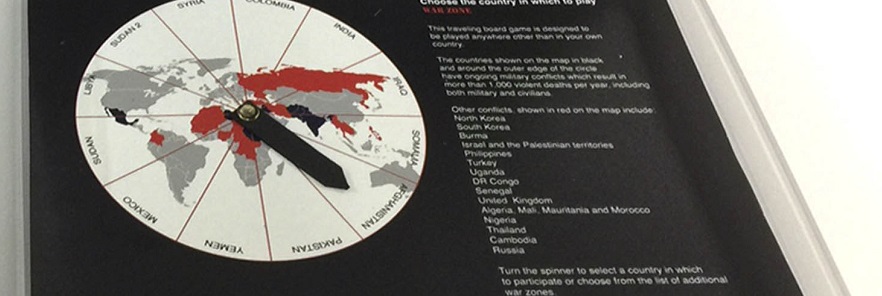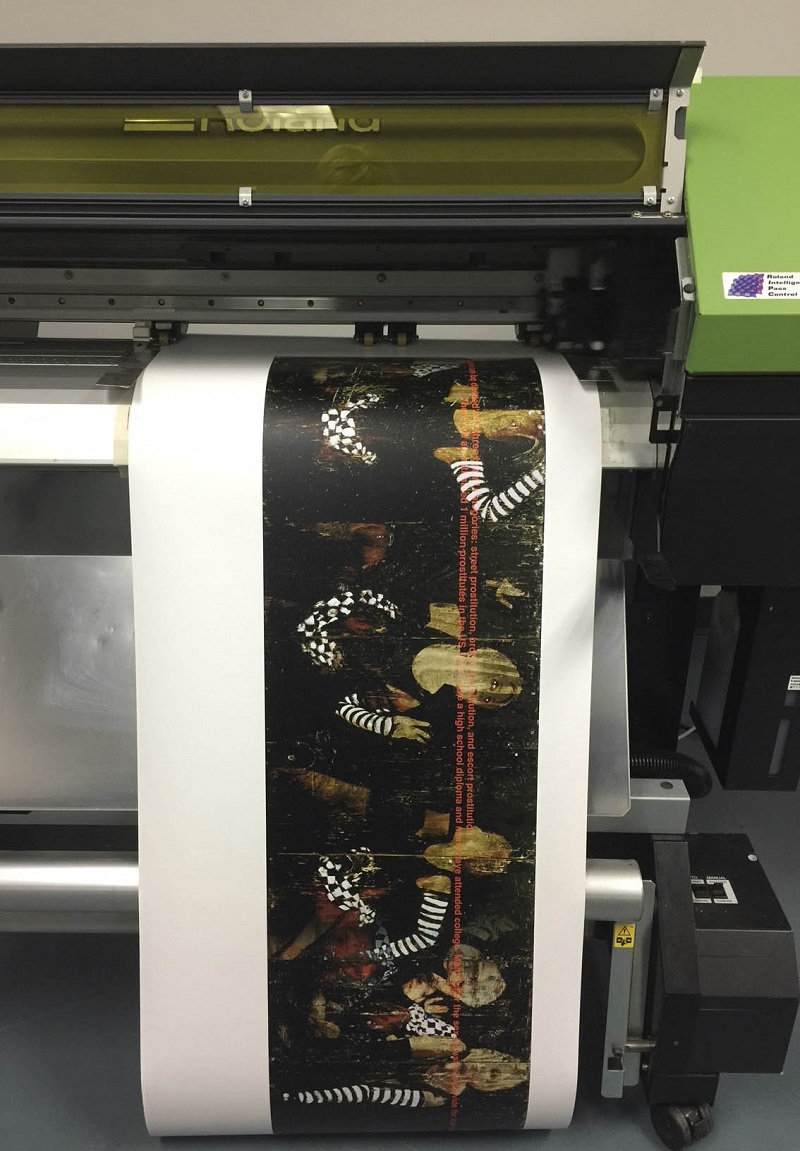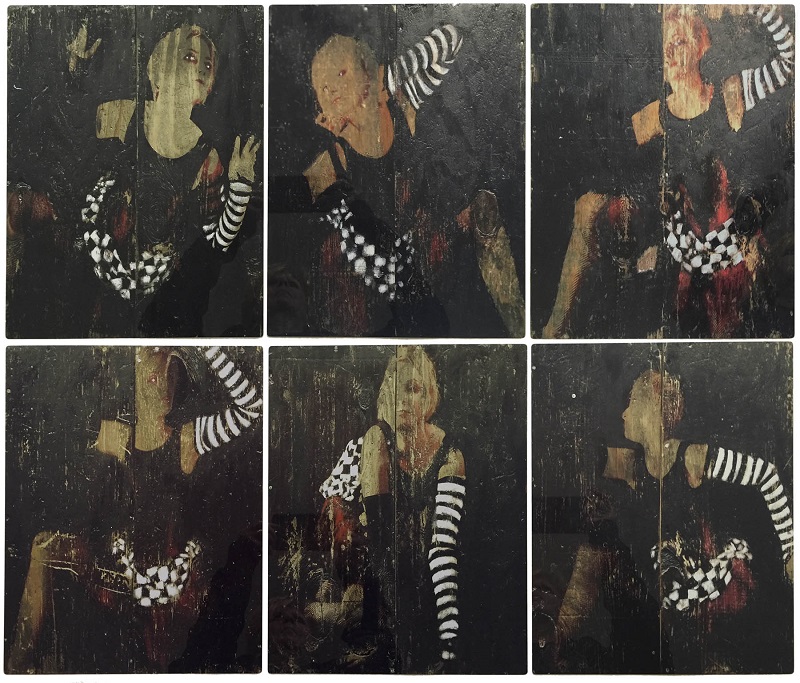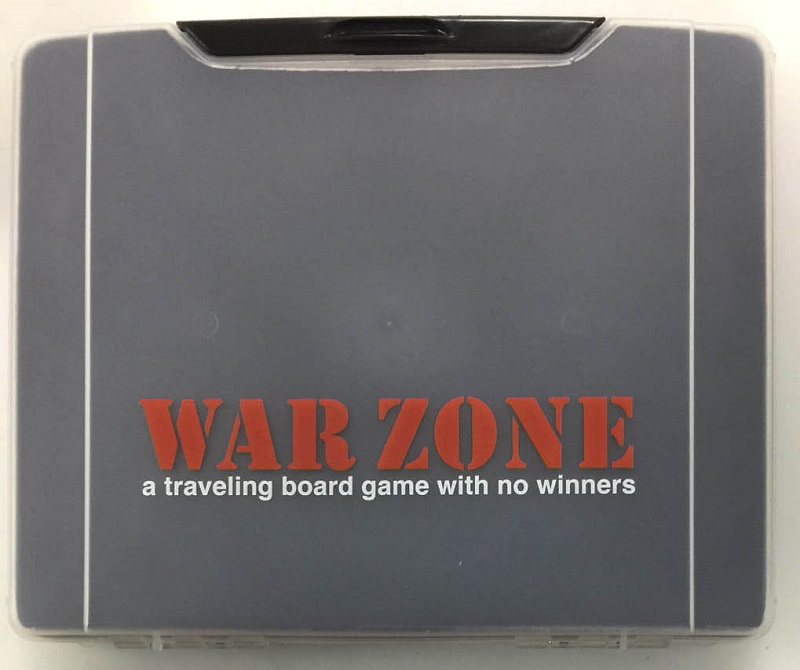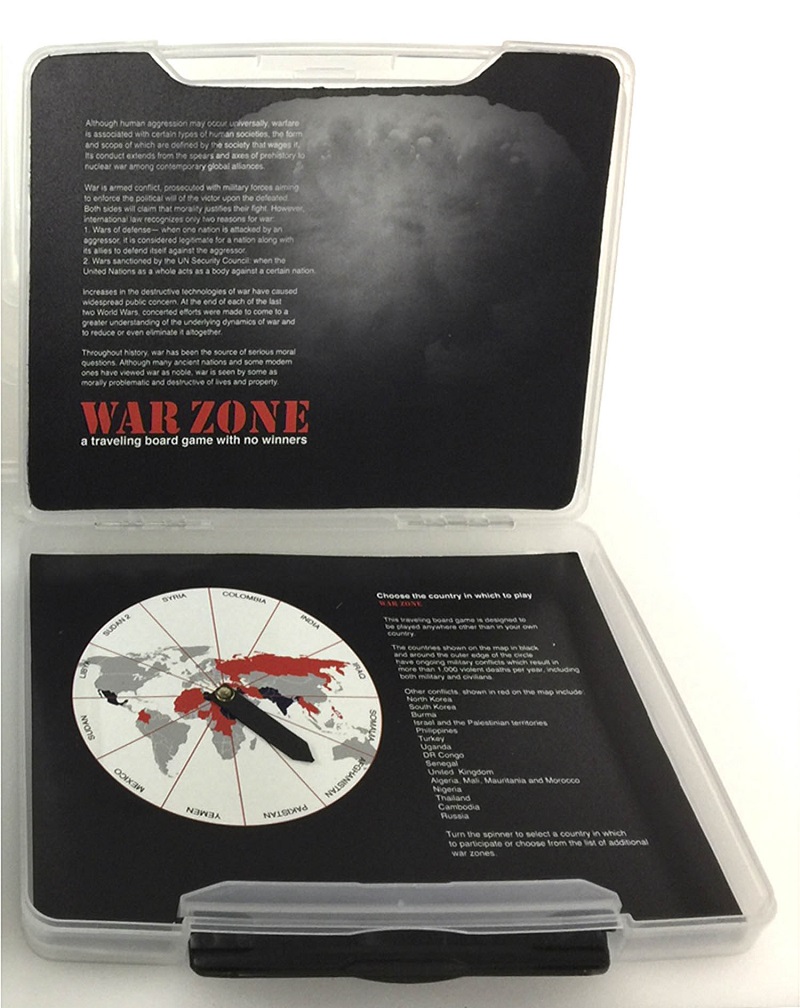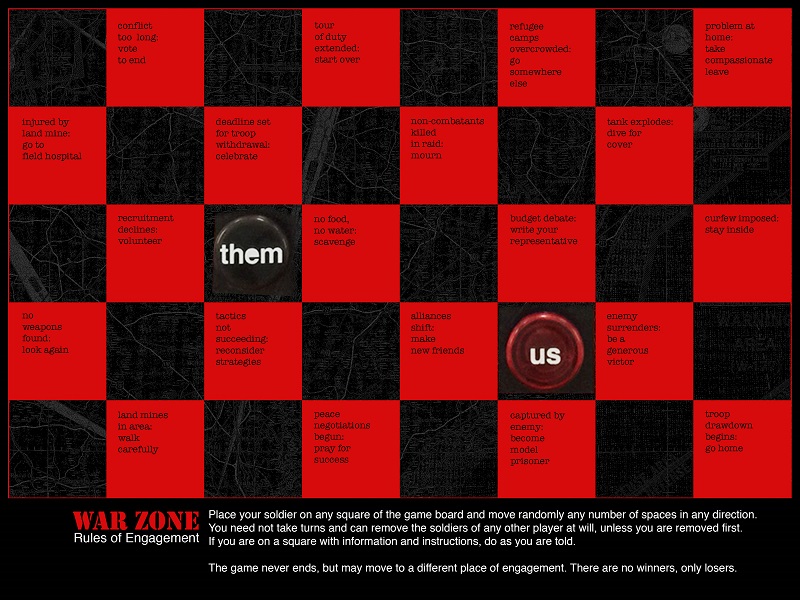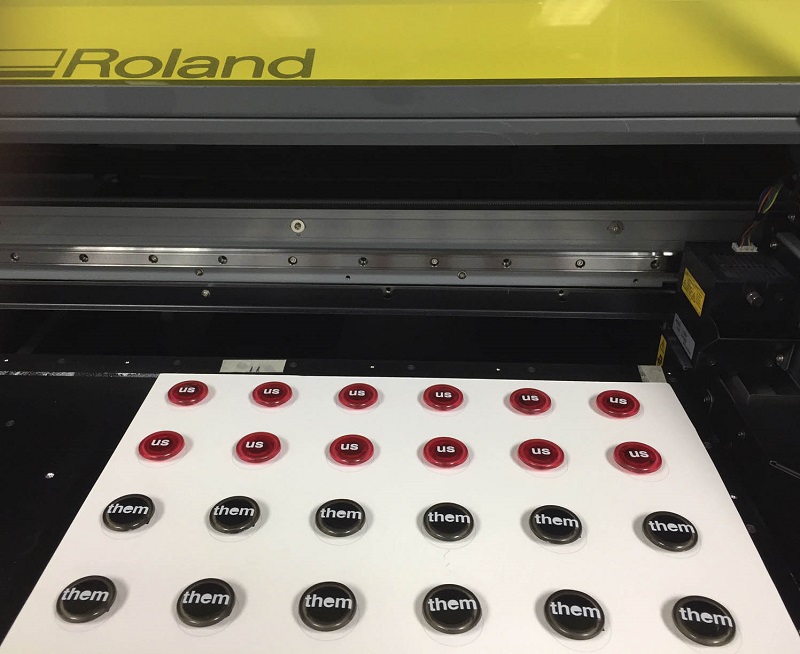If you own UV flatbed printers or dye sublimation printers, it can be difficult to imagine all of the creative ways the equipment can be used. So consider inviting a few local artists, designers, and makers into your shop and ask how they might use the printers’ capabilities.
For example, in January Roland DGA and artist Bonny Pierce Lhotka hosted a 3-day Imaginarium project at Roland’s headquarters in Irvine, California. Lhotka, author of the book ‘Hacking the Digital Print,’ helps photographers and artists understand how photographic images can be output or transferred to dozens of different surfaces. She has experimented with creative photo composition and printmaking techniques to create original mixed-media artworks on many surfaces beyond art papers and canvas.
During the Roland Imaginarium event, six artists, photographers, and multimedia designers made art with Roland VersaUV LEC printer/cutters, VersaUV LEF benchtop flatbed printers, and Texart dye-sublimation printers. Jay Roberts, product manager for UV devices at Roland DGA, led a team of printing experts who helped the Imaginarium artists experiment with different processes, materials, and machines.
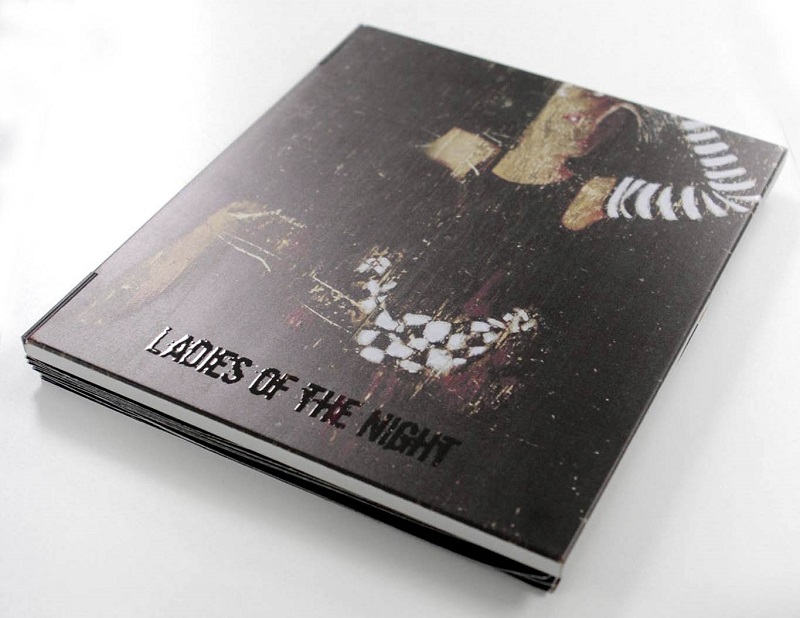
Artist Dorothy Simpson Krause came up with two thought-provoking projects: a limited edition art book (“Ladies of the Night”) housed in a decorated aluminum box and “WarZone,” a traveling board game with no winners.
Art Book in Decorated Aluminum Box
“Ladies of the Night” is a concertina book, meaning that the pages are printed in one continuous strip and folded like an accordion. When you grip the folded pages in one hand, you can flip through pages with the other. For this art book project, a 9.5 x 57-inch print was folded to 12 pages (9.5 x 11.5 inches each). It was housed in a 10 x 12-in. aluminum box that was printed with an image from the book.
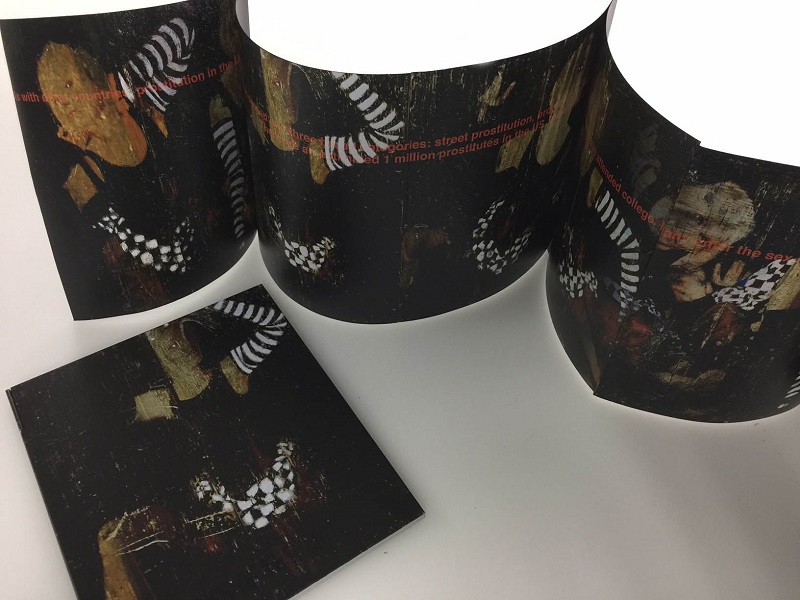
The pages featured digitally manipulated photographs Krause had taken in 2003 of twin performance artists Abigail and Emily Taylor for a series called “Body + Soul.” Text on the final page of the “Ladies of the Night” book provides statistics about prostitution in the United States.
“My project had several distinct challenges,” says Krause. “The ink needed to be as rich on the reverse as on the front and not soak into the uncoated back side. The prints had to be scored and folded into pages without having inks crack on the edges of folds. And the images on the back and front of the 57-inch long print had to be perfectly aligned.”
Jay Roberts recommended ways to resolve these issues. The books was printed with Roland’s Eco-UV S ink on a VersaUV LEC printer/cutter. The VersaUV printer typically prints on a range of flexible materials used in package printing.
The Eco-UV S ink is dense and flexible and was designed to shrink or stretch when wrapping vehicles.
For the “Ladies of the Night” book, the ink produced deep rich blacks on both the coated and uncoated surfaces of Roland’s Premium Matte Paper. And the ink didn’t crack when the pages were folded. A scoring machine was used to make indentations for folding the pages.
“The paper and ink were so heavy, it would have been difficult to score the pages by hand,” says Krause.
A Roland VersaUV LEF-300 flatbed printer was used to print the aluminum box that holds the book. To replicate the look and feel of an embossed book cover, a layer of clear gloss ink was applied to the letters of the book title.
To prepare the image the cover image for the box, the white on the costume was selected in Photoshop, saved as a spot channel and designated to print as a 100% white base layer on the aluminum. After the image layer was printed, the clear gloss layer was applied, using a file that included only the letters of the image with the red omitted.
Before the box was printed, the edges were taped to keep them clean from overspray from the printer. An outline template was printed on the surface of the flatbed to ensure consistent placement as the layers were printed.
As an add-on to the book project, Krause used Roland’s Texart RT-640 Dye Sublimation printer to transfer six images from the book onto 11 x 14 –inch aluminum panels that had been painted white and treated with a polymer coating.
The images were first printed in reverse with dye-sub inks onto dye-sub-transfer paper. The image transfer occurred when the prints were subjected to a controlled amount of heat and pressure in a flatbed heat press. During the heat transfer process, the inks became gases that permeated the coated surface of the metal. The print are very durable and scratch resistant and feel smooth to the touch.
“The white details of the costume are crisp and vibrant, while the underlying metals provides a glowing reflectivity,” said Krause.
War Zone: A Game Without Winners
“War Zone” is a traveling board game with no winners. The suitcase-like polystyrene box, game board, spinner, and “us” and “them” checker-like magnets were designed by Dorothy Krause and printed on Roland devices.
After printing an outline for the box on the surface of the UV VersaUV LEF 300 flatbed printer, the box a white layer was printed under the entire title, followed by a layer of gray and red. Ink. Two layers of gloss ink was printed over the “War Zone” title to provide an embossed-like effect.
The box was lined with contour-cut board printed with an image of the first atomic bomb blast and text about the nature of armed conflict and human aggression. A spinner board was contour cut and printed with a map that shows countries with ongoing military conflicts.
A checkerboard-like game board was printed on 9 x 12-inch matte board with the “rules of engagement” printed across the bottom. The “soldiers” are red and black magnets that were printed with white ink to read “us” or “them.”
Other Projects at Imaginarium
In addition to Bonny Lhotka and Dorothy Krause, other artists at the 2017 Roland Imaginarium included Jake Welin, Ileana Frometa Grillo, Karin Schminke, and Sean Teegarden. They used Roland printers to transfer photos and multi-layered image compositions onto pre-painted and plaster-treated canvases, transparent films, film reels, birchwood, pre-cut wood panels, and other unique media.
In a blog post that showcases the work of the six artists, Ben Fellowes of Roland DGA writes, “It was a pleasure to watch this talented group of artists at work and eye-opening to see what they did with our printing technology. At Roland, we have always understood the potential of our machines as fine art tools.”
Roland Equipment
The printers used at the Roland Imaginarium were’t specifically designed for artists, designers, and makers. But partnerships with creative professionals could ultimately help users of these devices create some strikingly beautiful products in the fields of apparel, awards, packaging, gifts, and interior decor.
The Roland VersaUV LEC series of UV printer/cutters was designed to print, contour cut, varnish, and emboss flexible substrates used to create bags, folding cartons, labels, and specialty graphics. This printer is available in 30-inch and 54-inch widths.
The Roland VersaUV LEF-300 Benchtop Flatbed printer can print directly on rigid and flexible materials up to 3.94 inches thick and up to 13 inches wide and 30 inches long. It is typically used to print on promotional products, giftware, awards, smartphones, tablets, jewelry, trophies and specialized signs.
The Roland Texart™ RT-640 dye-sublimation transfer printer can print high-quality images for transfer onto fabrics or hard goods including metal panels, wood, snowboards, and ceramic tiles.
Opportunities for Print Service Providers
Many artists, photographers, and designers now know they can earn income by licensing designs that print-service providers can output onto apparel, accessories, decorative art, tabletops, laminates, and fabrics.
Some entrepreneurial creative professionals are teaming up print-service providers to design and create their own branded lines of products for sale online or at art fairs.
According to Dorothy Krause, “Artists are becoming more and more aware of the advantages of flatbed printers, dye-sublimation printing, and contour cutting devices.” Printers that can use gloss, white, and metallic inks (such as Roland’s) are particularly versatile for creating interesting designs.
She believes artists and print-service providers can both benefit from working together to envision new and exciting ways to push the boundaries of what’s possible.

